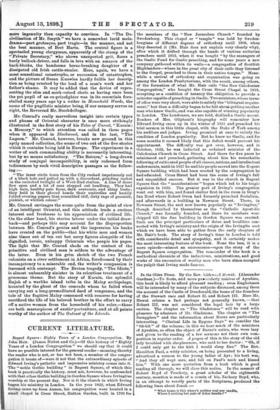CURRENT LITERATURE.
Regent Square : Eighty Years of a London Congregation. By John Hair. (James Nisbet and Co.)—Of this history of " Eighty Years of a London Congregation " we should say that it could have no possible interest for the general reader—meaning thereby the reader who is not, or has not been, a member of the congre- gation it treats of—were it not that the extraordinary episode of Edward Irving's pathetic and impressive ministry comes into it. The " noble Gothic building " in Regent Square, of which this book is practically the history, must not, however, be confounded with that other Gothic building in Gordon Square where Irvingites worship at the present day. Nor is it the church in which Irving began his ministry in London. In the year 1822, when Edward Irving came up from Annan, his congregation were located in a small chapel in Cross Street, Hatton Garden, built in 1796 for the members of the " New Jerusalem Church " founded by Swedenborg. This chapel or "temple" was held by Sweden. borgians of different degrees of orthodoxy until 1805, when they deserted it (Mr. Hair does not explain very clearly why), after which it drifted through the hands of various sectarian preachers until 1812, when it was bought "by the managers of the Gaelic Fund for Gaelic preaching, and for some years a new company gathered within its walls—a congregation of Scottish Highlanders—where in the great city of their exile they listened to the Gospel, preached to them in their native tongue." Mean- while a revival of orthodoxy and organisation was going on among the London Presbyterians, with the result, among others, of the formation of what Mr. Hair calls "the New Caledonian Congregation," who bought the Cross Street Chapel in 1818, accepting as a condition of tenancy the obligation to provide a minister capable of preaching in Gaelic. Two ministers, whose terms of office were very short, were able to satisfy the "bilingual require- ment," but then a difficulty began to be felt about getting another man who knew Gaelic, and was also capable of winning popularity in London. The Londoners, we are told, disliked a Gaelic accent. Readers of Mrs. Oliphant's biography will remember how Edward Irving came up in the winter of 1821 and preached his trial sermon in this little chapel, with the Duke of York among his auditors and judges. Irving promised at once to satisfy the condition of London popularity. But he knew no Gaelic, and for some months it seemed likely that this defect would prevent his appointment. The difficulty was got over, however, and in October, 1822, he was inducted as ordained minister of the Caledonian Church in Cross Street. And there for five years he ministered and preached, gathering about him his remarkable following of cultivated people of all classes, nations, and intellectual endowments, until in 1827 he and his people moved into the Regent Square building which had been erected by the congregation he had educated. Cross Street had been the scene of Irving's full and unqualified success. But it was in the church in Regent Square that the " manifestations " began which led to his tragic expulsion in 1833. The greater part of Irving's congregation went out with him, and found shelter first in the room in Gray's Inn Road where Robert Owen had formerly preached Socialism, and afterwards in a building in Newman Street. There, in Newman Street, the sect now known popularly as "Irvingites," though described by themselves as the " Catholic Apostolic Church," was formally founded, and there its members wor- shipped till the fine building in Gordon Square was erected. Such are the principal particulars of dates and localities con- nected with Irving's ministry and the origin of the Irvingite sect which we have been able to gather from the early chapters of Mr. Hair's book. The story of Irving's time in London is told with considerable detail and sympathy, and it certainly makes the most interesting feature of the book. None the less, it is a mere episode—almost an excrescence—upon the story of the Regent Square congregation. The remainder of the book is a methodical chronicle of the inductions, ministrations, and good works of the succession of worthy men who have since occupied the pulpit that Irving made famous.


































 Previous page
Previous page